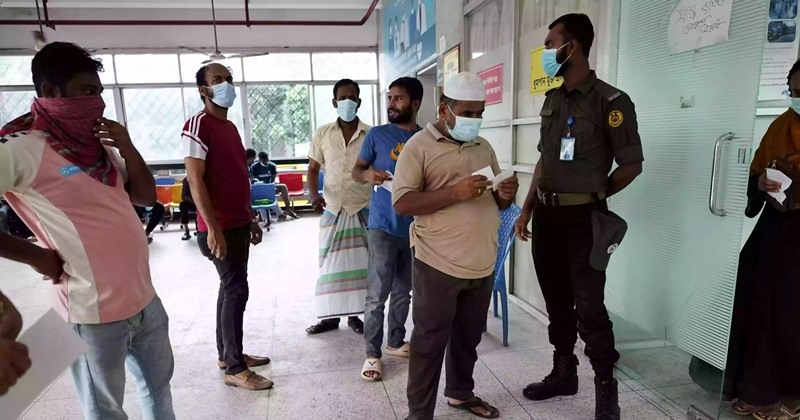- CA Yunus pays homage to Liberation War martyrs on Victory Day |
- Bangladesh capital market extends losing streak for second day |
- Bangladesh celebrates Victory Day Tuesday |
- 'Different govts presented history based on their own ideologies': JU VC |
COVID sub variant wave hits Bangladesh; vigilance urged

Some people in a queue for COVID 19 screening in a Dhaka hospital on Saturday. Photo Shamsul Alam Hady - UNB.
A fresh wave of COVID-19 infections is sweeping across Bangladesh, triggered by the fast-spreading Omicron sub-variants JN.1, XFG, and XFC, reigniting public health concerns and prompting calls for renewed vigilance.
While health authorities confirm a gradual rise in case numbers, experts stress that the overall severity remains low and the situation does not warrant public panic.
The Directorate General of Health Services (DGHS) confirmed that the two new sub-variants—XFG and XFC, both offshoots of the JN.1 lineage—were first identified in April 2025 at Chattogram Medical College Hospital.
Since then, COVID-19 positivity rates have steadily increased, particularly across nine surveillance districts monitored by icddr,b: Kishoreganj, Rajshahi, Cumilla, Khulna, Jashore, Sylhet, Barishal, Chattogram and Dinajpur.
Data from these areas show that in May alone, around 7% of patients at study hospitals tested positive for the new variants, a significant leap from near-zero levels earlier this year.
New Symptoms, Low Severity
Despite the uptick, medical professionals emphasise that most cases are mild in nature.
The predominant strains currently circulating include JN.1, LF.7, XFG, NB 1.8.1, and BA.2.86. While symptoms have shifted slightly—many patients now report loss of taste along with fever—hospitalisation rates remain manageable.
Dr Mizanur Rahman, Superintendent of Kuwait Moitri Hospital, reported that patients with suspected new variant symptoms are being referred to the DNCC COVID-19 Dedicated Hospital.
“Most complain of losing their sense of taste and have mild fevers. As of today, six patients are admitted and we’ve requested additional testing kits in anticipation of increased demand,” he said.
Testing Capacity and Govt Preparations
DGHS Director Dr Mainul Ahsan has assured the public that testing kits are available in abundance. “There is no shortage. If any facility faces a stockout, they should inform us. We are far better prepared now than in 2020,” he said.
Echoing this, Halimur Rashid, Line Director at the Centre for Disease Control (CDC), noted, “The dominant strain is Omicron JN.1, and while three fatalities have occurred—all in individuals over 70—the symptoms across the board are largely unchanged. Widespread panic is unwarranted.”
Lukewarm Public Response
Despite health warnings, public response has been largely indifferent.
At the DNCC Hospital, Rafiqul Islam, who brought in a relative with a fever, dismissed concerns. “We don’t think it’s COVID. People are just overreacting,” he said.
Another visitor, Sirajul, admitted to experiencing classic COVID symptoms—fever, body aches, and shortness of breath—but hadn’t taken any action. “I thought it was just seasonal flu,” he shrugged.
A visit to the DNCC COVID-19 Dedicated Hospital on June 14 revealed 16 patients admitted, mostly adults over 30, with only one child aged 11. But, tracking accurate data proved difficult due to outdated logs and a lack of on-duty medical staff.
Ultimately, security personnel helped confirm the patient count.
Rising Mask Prices Amid Renewed Demand
As infections rise, face mask prices have surged in the wholesale markets. Opportunistic traders are reportedly cashing in on growing demand.
A visit to Babubazar in Dhaka revealed large crowds of retailers rushing to stock up on masks, with wholesale prices nearly doubling within days.
Latest Infection and Death Toll
DGHS data indicates that between the mornings of 12 and 13 June, two COVID-related deaths were recorded—one each in Dhaka and Brahmanbaria.
Fifteen new infections were confirmed during the same 24-hour period. Seven more cases were identified on 14 June from 139 tests, while five patients recovered. No additional deaths were reported that day.
As per Worldometer, Bangladesh’s total confirmed COVID-19 cases now stand at 2,049,377, with 29,493 deaths since its inception to date.
11 DGHS Directives for Public Protection
In light of the current surge, DGHS has issued 11 key health guidelines:
Avoid crowded places; wear masks if attendance is necessary.
Always use a mask to protect against respiratory illnesses.
Cover mouth and nose when coughing or sneezing.
Dispose of tissues in covered bins immediately.
Wash hands frequently or use sanitiser for at least 20 seconds.
Refrain from touching the face with unclean hands.
Maintain at least 3 feet distance from symptomatic individuals.
Stay home if experiencing fever, cough, or breathing issues.
Ensure symptomatic persons wear masks.
Caregivers must also wear masks.
Seek medical attention if needed by calling the nearest hospital, IEDCR at 01401-196293, or the health hotline at 16263.
Preparedness Over Panic
While the rising infection rate is being closely monitored, experts and authorities continue to underscore that the situation is under control.
They said the majority of the population is vaccinated and health infrastructure is significantly better equipped compared to previous outbreaks.
With continued vigilance and responsible public behaviour, officials believe Bangladesh can weather this new wave with minimal disruption. - UNB

